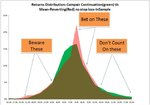Hi All,
I am now trading continuation systems and would like to add a mean-reverting system to compliment my portfolio. I compare the returns distribution of the two systems below. (pls see attachment)
The red curve is for MR while the green one is for CON systems. Both have positive expectations. You can see that the big chunk of returns is cluttered at small gains level for MR. My question is on exit strategies. Given these two systems, how would you design exit strategies differently.
Exit strategies issues are
1.) Stop-loss
-(Fix or volatility-based)
-(Tight or loose)
2.) Profit-target
-To have or not to have
-Tight-loose
3.) Time-Exit
-To have or not to have
Anyone has experience dealing with MR type systems?
Any other thoughts are welcomed. Thank you
I am now trading continuation systems and would like to add a mean-reverting system to compliment my portfolio. I compare the returns distribution of the two systems below. (pls see attachment)
The red curve is for MR while the green one is for CON systems. Both have positive expectations. You can see that the big chunk of returns is cluttered at small gains level for MR. My question is on exit strategies. Given these two systems, how would you design exit strategies differently.
Exit strategies issues are
1.) Stop-loss
-(Fix or volatility-based)
-(Tight or loose)
2.) Profit-target
-To have or not to have
-Tight-loose
3.) Time-Exit
-To have or not to have
Anyone has experience dealing with MR type systems?
Any other thoughts are welcomed. Thank you

